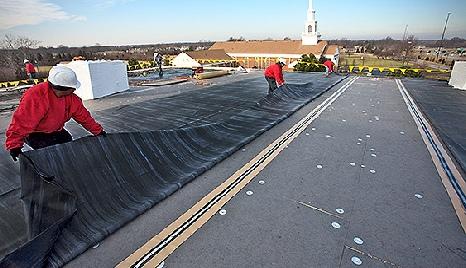EPDM (Ethylene Propylene Diene Terpolymer) roofing is a popular choice for both residential and commercial buildings due to its durability and long lifespan. However, the temperature during the installation process plays a crucial role in ensuring the success and longevity of an EPDM roof. In this article, we will explore the importance of temperature in EPDM roofing installation. We will discuss the optimal temperature range for the installation, the effects of extreme temperatures, and the considerations that need to be taken into account to achieve a successful and durable EPDM roof.

Understanding Optimal Installation Temperature:
Installing EPDM roofing at different temperatures can have a significant impact on both the installation process and the final outcome. The ideal temperature range for EPDM roofing installation is typically between 40°F (4°C) and 100°F (38°C). Within this range, the EPDM membrane can easily conform to the roof’s contours, ensuring proper adhesion and a seamless installation.
Effects of Low Temperatures:
- Material Flexibility: In colder temperatures, the EPDM membrane may become less flexible and more challenging to work with. It can stiffen, making it difficult to stretch and properly fit the roofing substrate.
- Adhesive Performance: Adhesives used in EPDM roofing installation may have reduced effectiveness in colder temperatures. Cold temperatures can slow down the curing process of the adhesive, resulting in inadequate bonding between the membrane and the roof substrate.
- Seaming Issues: Cold temperatures can also affect the seaming process of EPDM roofing. Seams may not properly fuse together, leading to potential leaks and decreased overall performance of the roof.
Effects of High Temperatures:
Material Expansion: In high temperatures, EPDM roofing membranes can expand, making it challenging to achieve accurate measurements and proper alignment during installation. This expansion can lead to wrinkles, buckling, and potential damage to the membrane.
Adhesive Application: Excessive heat can cause adhesives to dry too quickly, leading to poor adhesion and compromised bonding between the EPDM membrane and the roof substrate.
Workability: Extreme heat can make the EPDM membrane more pliable, increasing the risk of stretching or tearing during installation. It becomes crucial to handle the material with care to prevent damage.
Considerations for Successful EPDM Roofing Installation:
Temperature Monitoring: Before starting the installation process, it is essential to monitor the ambient temperature and surface temperature of the roof. This will help determine whether the conditions are within the recommended range for EPDM roofing installation.
Timing: It is advisable to schedule EPDM roofing installation during moderate temperatures, typically in the spring or fall seasons when the weather is more temperate and stable.
Equipment and Materials: Ensure that all equipment and materials are stored in a temperature-controlled environment before and during the installation process. This includes adhesives, primers, and the EPDM membrane itself.
Professional Installation: Hiring a professional roofing contractor experienced in EPDM installation is crucial to ensure that the process is done correctly, considering temperature factors and following industry best practices.
Conclusion:
Temperature plays a vital role in the successful installation of EPDM roofing. Understanding the optimal temperature range, as well as the effects of both low and high temperatures, is essential to achieve a durable and long-lasting EPDM roof. By monitoring the temperature, considering timing, and relying on professional expertise, you can ensure a smooth and effective EPDM roofing installation. Always consult with a qualified roofing professional to ensure that the temperature conditions are suitable and to achieve the best results for your EPDM roofing project.



Leave a Reply